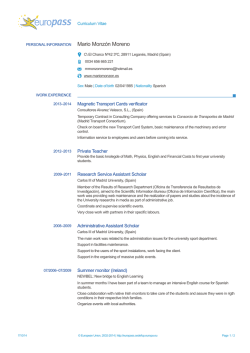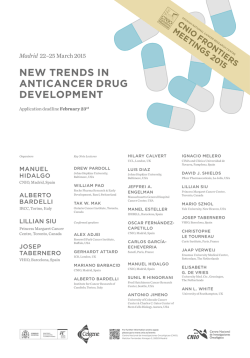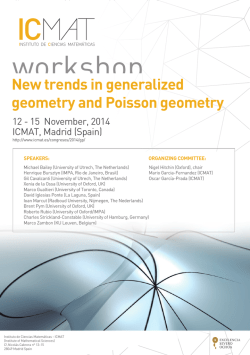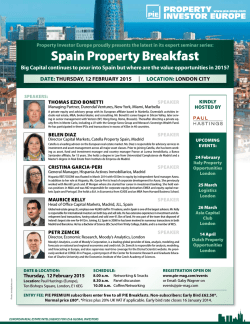
INTERNATIONAL - Residencia de Estudiantes
International LINKS OF Spanish culture RESIDENCIA DE ESTUDIANTES UNTIL MARCH 8 2015 Severo Ochoa (wearing cap), Curt Fisher and another English doctor during their trip to the 12th International Congress of physiology, held in Boston in 1929. Museu de les Ciénces Príncipe Felipe, Archivo Severo Ochoa, Valencia. D etailing the process through which Spanish culture forced itself back onto the International platform, this exhibition demonstrates how Spain went about rediscovering its sense of modernity after a lengthy period of self insulation. For Spanish society, the vital turning point came in 1914 in the form of Francisco de los Ríos and his team at the Institución Libre de Enseñanza (ILE). By working in close contact with the Junta para Ampliación de Estudios e Investigaciones Científicas (JAE), it was their template for modernisation that brought about this process of change. Vital components in the continuation of a liberal Spanish tradition, 1914 was the final year that saw Francisco de los Ríos, Miguel de Unamuno, and José Ortega y Gasset coincide. It was this tradition, so intimately linked to universality, cosmopolitism, and the collective European conscience, that offered such stark contrast to the violence being precipitated across the rest of the Old Continent. In what would later be seen as the first throws of a period of lasting conflict, this obvious contradiction was felt strongly, and critically, by Spanish intellectuals from the very start. It was this sentiment that harboured a powerful sense of neutrality throughout Spain and resulted in the offering of refuge to a vast number of intellectuals and artists from across the world. Allowing these great thinkers to continue with their work, this safe haven brought with it the inevitable influx of content and a stream of new works of art, clearly benefiting Spain in the process. Once the war ended, the vast network of contacts established over previous years continued to flourish, contributing hugely to the cultural splendour of the interwar period. Spanish society was dramatically transformed, with a wave of new ideas, ways of thinking, and discoveries, both artistic and scientific, very much moving to the forefront. In the same moment, the world is shaken by the economic recession at the end of the second decade of the century, as well as the Fascist, Nazi, and Soviet totalitarianism regimes that darkened the next. The result of this was, of course, the Second World War. And, in the case of Spain, the start of Franco, exile, and a regime that would go on to plague the country for the next four decades. 3 The exhibition pays homage to a number of those pioneering Spaniards who sought success both domestically, and internationally, whilst also presenting some of those that arrived in Spain from abroad. Also represented are various institutions that played key roles in this process, along with a detailing of the vital collaboration between Spanish education, science, and culture and their European and American counterparts. Without these channels connecting Spain to the rest of the world, the flourishing Mexican culture, along with various aspects of brilliant investigation in the United States, would not have been possible. Nobel Prize winner Severo Ochoa always stressed that his scientific career would not have been the same without those pivotal formative years spent at the Residencia de Estudiantes, and the important and lasting relationships forged in its laboratories. Ignacio Zuloaga with Auguste Rodin (sitting) and the Russian collector Ivan Stchoukine during a trip to Spain, circa 1905. Archivo Fundación Zuloaga. 4 José Ortega y Gasset reading the announcement of the First World War in front of the Residencia de Estudiantes at number 14, Fortuny Street. Residencia de Estudiantes, Madrid. 1 BY EUROPE AND AMÉRICA T he key to Spain’s eventual internationalisation can be found deep within the small print of Sanz del Río’s original travels to the great German institutions of learning in 1843, along with those later undertaken by Giner, Cossío, and various others. Working through the National Pedagogical Museum and seeking foreign partners for the ILE, the purpose of these trips was to learn first hand from the experiences of other countries, in order to then incorporate these educative practices into their own plans for reform. The Bulletin of the Free Institution of Education (BILE), the Spanish magazine of reference for educational, philosophical, sociological, and scientific material, collected and disseminated the results of this task. The Junta para Ampliación de Estudios was created in January 1907 to provide funding for Spanish students and graduates looking to complete their studies at some of the finest universities in the world. Striving both domestically and internationally, another of the board’s key objectives was to articulate the work being done within the various fields of culture and living. Beginning for the first time in Spain, it was a political move capable of finally launching the country onto the international platform of scientific discussion. 7 Spurred on by the positive winds coming from a new liberal government, the JAE founded a new wave of institutes in 1910 (the Residencia de Estudiantes and the Centro de Estudios Históricos among them). Supported by the increasingly frequent interchange that occurred over the coming decades, these institutes paved the way for the formation of a new, modern scientific and artistic network. The International Institute for Girls in Spain moved to Madrid during the early part of the century, where it swiftly became a beacon of cultural exchange between the peninsula and North America. In 1904 Archer M. Huntington founded the Hispanic Society of America, with this going on to play a vital role in the diffusion of Spanish culture within the United States. Other prominent examples of this growing international relationship came in the field of the arts. The names of Fortuny, Zuloaga, and Joaquin Sorolla, the most internationally recognized Spanish artists of their time, became synonymous with all things good in Spain at the time. The famous dancer, La Argentina, was widely appreciated, as were those Spanish musicians whose works are successful worldwide; Albéniz, Granados, and Falla. Boletín de la Institución Libre de Enseñanza Since first issuing in March 1877, the Boletín de la Institución Libre de Enseñanza (BILE) has been one of the leading Spanish journals on the subject of experimental and social sciences, as well as education. It reviewed the contents of various major European and American publications, including regular collaborations with foreign authors, Spanish institutions, and their international colleagues, working to establish a respectable web of sources. From the creation of the weather service in Japan, until the first reports of radioactivity, automotives, and wireless telephone, the BILE was one of the prime sources of knowledge as to what was happening throughout the world. Santiago Ramón y Cajal International recognition of Cajal began at the Congreso de la Socie¬dad Anatómica Alemana (Berlin, October 1889). Addressing some of the leading neuroscientists of his time, Cajal presented and defended his neuronal theory. Ac8 © Ignacio Zuloaga, VEGAP, Madrid, 2014. Ignacio Zuloaga y Zabaleta, Portrait of Madame Malinowska (The rusian), Paris, 1912. Oil on canvas, 197 x 98 cm. Museo Nacíonal Centro de Arte Reina Sofía, Madrid. 9 knowledgments came in cascade thereafter: in 1894 he delivered the famous Croonian Lecture, where he addressed the Royal Society, and the University of Cambridge awarded him with an honorary doctorate; In 1896 he received the Fauvelle Prize of the Society of Biology of Paris and was invited to the Society of Psychiatry and Neurology in Vienna, as well as being appointed doctor honoris causa by the University of Würzburg. His most prestigious international awards: Award Moscow International Congress of Medicine (1900), the Helmholtz Medal of the Imperial Academy in Berlin (1905) and the Nobel Prize in Medicine or Physiology (1906). The International Institute in Spain The International Institute for Girls in Spain was founded by Alice Gordon Gulick. Intent on encouraging, and furthering, education amongst young people in Spain, the institute was established in Madrid during the early throws of the twentieth century. Following the example set by North American female colleges, the institute acquired a building on Fortuny Street, whilst embarking on the construction of another; number eight, Miguel Ángel. Through the consistently high quality of its studies and languages, and even its sport, the institute strived constantly to distinguish itself from the rest of Spanish education. The First World War, particularly after the arrival of the United States, deeply impacted the institute to its very core. This resulted in Susan Huntington, director of the institute between 1910 and 1918, reinforcing the ties with the JAE, strengthening an agreement first made in 1917. The Hispanic Society of America The Hispanic Society of America was founded in 1904 by the tycoon and philanthropist, Archer Milton Huntington, who in his travels throughout Spain had come into contact with the ILE and had formed a fast friendship with some its members. In 1908 the doors opened to the society’s headquarters in New York, with Huntington contributing heavily to the already rich collections of Spanish art and literature. The society would organise remarkable exhibitions featuring the likes of Sorolla and Zuloaga, whilst also editing numerous publications relating to His10 Escena de café (16,9 x 23,7 cm). Sketch by Joaquin Sorolla on paper, 1911. Museo Sorolla, Madrid. panic culture. Sorolla was even commissioned to paint the library, decorating the room’s fourteen panels with representations of Spain’s individually diverse regions, along with various eminent Spanish figures. Huntington funded a number of varying projects undertaken by Menéndez Pidal and his disciples at the Centro de Estudios Históricos. He was a collaborator in the creation of a Chair at the University of Columbia that, from 1916 onwards, was occupied by Federico de Onis. He was also a seminal character in the promotion, study, and dissemination of Spanish culture within the United States. Joaquín Sorolla Joaquín Sorolla (1863-1923) won over the European and North American public through a series of outstanding individual exhibitions, put on by the His 11 Mariano Fortuny y Madrazo, Traje Delphos, 1910. Woven with violet pleated silk and satin. Museo del Traje, CIPE, Madrid. 12 panic culture. Sorolla was even commissioned to paint the library, decorating the room’s fourteen panels with representations of Spain’s individually diverse regions, along with various eminent Spanish figures. Huntington funded a number of varying projects undertaken by Menéndez Pidal and his disciples at the Centro de Estudios Históricos. He was a collaborator in the creation of a Chair at the University of Columbia that, from 1916 onwards, was occupied by Federico de Onis. He was also a seminal character in the promotion, study, and dissemination of Spanish culture within the United States. Joaquín Sorolla Joaquín Sorolla (1863-1923) won over the European and North American public through a series of outstanding individual exhibitions, put on by the Hispanic Society of America in Paris (1906), London (1908), the United States (1909) and later (1911), the Institution of Art in Chicago and el Museo de Arte de San Luis. From then onwards, numerous large museums and collections strived to incorporate the work of this great painter. As evidenced by the notes and drawings in this sample, the vast human landscape of New York City quickly caught his eye. The little known portrait of his daughter, titled Elena con sombrero (Elena with a hat), formed part of the exhibitions in both Chicago and Saint Louis. The fact that Sorolla’s New York exhibition – so close to Giner, Cossío, and the institute – was first organised by the Hispanic society at its headquarters is the highest proof of the spiritual connection between Archer M. Huntington and ILE. Mariano Fortuny Mariano Fortuny and Madrazo (1871-1949), heir to a rich family tradition, worked as a painter, printmaker, photographer, in textiles, and as a fashion designer. In Venice, where he settled from 1891 onwards, he devised one of his most original works, the dress Delphos; woven with pleated silk and inspired 13 by Greek art, it is a powerful symbol of modernity that does not shy away from the past. Falla’s success in France “The return of Manuel de Falla in 1914, after a seven year stay in Paris, and through the Spanish premier of his new opera La vida breve (The short life), considered a great success in both Paris and Nice, saw him attempt to combine the flourish of a purely musical work with the caustic criticism of a journalist. For its quality, Manuel de Falla represented the renewal of our music, the epitome of a trend under which Spanish music entered a new period and was put on a plane of elevation, a worthy criterion of being likened to the most intense and alive contemporary art from across the world.” (Adolfo Salazar, El Sol, 1919). Within the Russian Ballet “I attended the first performance of El sombrero de tres picos (The Three-Cornered Hat), by Manuel de Falla. Although already mad Nijinsky, Diaghilev’s Russian ballet continued to amaze the world whilst removing it from the traditional artistic environment. At the premiere, in addition to discovering the exciting rhythm of flamenco, deeply loved by de Falla, all the grace and creative drive of Picasso was revealed to me. That wonderful indigo curtain on that suggestive jumper with the black eyes, those boiling lime walls and well, all that simple and warm geometry merging that vibrant hub and those colorful dancers!”. (Rafael Alberti, La arboleda perdida). © Sucesión Pablo Picasso. VEGAP, Madrid, 2014. Antonia Mercé, La Argentina The Spanish dancer Antonia Mercé (1890-1936), better known as La Argentina, was an extraordinary creative determined on broadcasting himself worldwide. In Paris he premiered two works by Manuel de Falla: El Amor Brujo (The Bewitched Love) and El sombrero de tres picos. Los Ballets Espagnols were created in the late twenties, following the example of Sergei Diaghilev’s Ballets Russes. Collaborating and working in close cosontext with his comPablo Ruiz Picasso, decorated for the final model of the ballet pany were writers like Cipriano de Rivas Cherif, composers like Falla, and El sombrero de tres picos (Le tricorne), for Manuel de Falla, de Tejada. In 1929 he was paid tribute in New York, where painters like Sáenz circa 1918-1919. Stenciled, 19,8 x he cm. had worked with remarkable success-with the participation of Federico 26,8 Archivo Manuel de Falla, Granada. 14 2 Between Wars García Lorca, Gabriel García Maroto, Federico de Onís and Ángel del Río. 15 Joaquín Torres García. Composición constructivista, 1930. Etched wood, 40 x 26,6 cm. Guillermo de Osma, Madrid. Juan Gris, La bouteille de vin (Bottle of wine), July, 1918. Oil on canvas, 55 x 38 cm. Museo Nacional Centro de Arte Reina Sofía, Madrid. Sonia Delaunay, Disque Portugal, 1915. Tempera paint on paper, 20,7 x 27 cm. Colección Fundación Mapfre. © de la obra de Sonia Delaunay: el titular de los mismos 16 W hen the First World War ended in November 1918, until the outbreak of the Spanish Civil War in July 1936, Spain experienced its second Golden Age: a period in which culture reintegrated itself into the international scene. An age of splendour, of international venture and of contributions to modernity, trapped between two moments of upheaval which saw Spain isolated from more advanced countries. As people and institutions carried out their work, their correspondence increased and their contact lists grew. The Junta para Ampliación de Estudios and its institutions contributed to this: the Residencia de Estudiantes, with it’s shining plethora of lecturers; it’s female branch, the Residencia de Señoritas, which continued to strengthen its collaboration with the International Institute for Girls in Spain; the Centro de Estudios Históricos and its magazine Revista de Filología Española or the Instituto Nacional de Física y Química, the building of which was financed by the Rockerfeller Foundation. Moreover, new and strong bridges were built between Spain and America through the Institución Cultural Española de Buenos Aires, new collaborations with the Hispanic Society and through the creation of the Instituto de las Españas at Columbia University. Spanish creatives travelled to Paris and New York, attracted by the inspiration stemming from visitors, contacts and publications that were key for their creative process like the Revista de Occidente. As a result, the most important cultural happenings were felt on both sides of the Atlantic, allowing distinguished groups of scientists, creators, humanists and teachers to create an intense network of personal and institutional connections over these years. Foreign intellectuals in Spain In 1914, the palaeontologist Hugo Obermaier – a man who would later become the master of an entire generation of Spanish palaeontologists and prehistorians – moved to Madrid, welcomed by the Comisión de Investigaciones Paleontológicas y Prehistóricas de la JAE. In the same year, Alfonso Reyes also arrived in Madrid, where he would live until 1924, collaborating with the Centro de Estudios Históricos (CEH) and paying frequent trips to the Residencia de Estudiantes. During his time in Spain, Dominican philologist Pedro Henríquez Ureña also collaborated with the CEH, a link that would continue in his 17 work with Amado Alonso in Buenos Aires. After the crisis that led to his participation in the war, JB Trend, the musician and future first Spanish lecturer at the University of Cambridge (1933), travelled to Spain in 1919 where he met Manuel de Falle and Federico García Lorca, visited Cossío in the Institución Libre de Enseñanza and became acquainted with Alberto Jiménez Fraud and the Residencia, with which he would collaborate until 1936. Trend undertook the difficult task of investigating and salvaging old Spanish music – madrigals in particular, which he made known throughout the world, managing to get them included in the repertoires of reputable British groups. In addition, he propelled the incorporation of the works of various Spanish composers, such as Albéniz, Falla and Gerhard, into the European musical canon and spread the success of Giner and ILE’s modernisation project through his books. Foreign creators in Spain The European creators who arrived in Spain between 1910 and 1920 – many of which fleeing the Great War-, brought new artistic trends with them that would circulate throughout Europe. Such was the case of the Delaunay couple; Albert Gleizes, who lived in Barcelona from 1916; Francis Picabia, also a resident of Barcelona for some time, where he founded the Dadaist magazine 391; and the painter Joaquín Torres García, equally linked with the city. With the outbreak of the First World War, María Blanchard returned to Spain from Paris, accompanied by the Mexican painter, Diego Rivera, with whom she shared a studio in Madrid, both participating in the exhibition Pintores íntegros, organised by Ramón Gómez de la Serna in 1915. Rafael Barradas and Norah Borges, as well as Polish refugees Wladyslaw Jahl and Marjan Paszkiewicz, contributed to the magazines of the growing Ultraist movement, a literary movement with the intention of opposing Modernism. Vicente Huidobro, a Chilean who had been living in Paris since 1916, also visited Madrid, where he published a number of his works and initiated an influential friendship with the then young poets Gerardo Diego and Juan Larrea. The Spaniards living in Paris Exhibition In March 1929, the Residencia de Estudiantes organised the Exposición de pinturas y esculturas de españoles residentes en París (Exhibition of paintings and sculptures by spanish artist living in París) in Madrid’s Botanical Gardens 18 The president of the Asociación Cultural Española de Buenos Aires Avelino Gutiérrez (fifth from the left) joined by some of those attending the party that the Residencia de Estudiantes hosted in his honor on the 12th of February, 1920. Among them, Santiago Alba, Alberto Jiménez Fraud, Natalio Rivas, Leonardo Torres Quevedo and Rafael Altamira (second, third, sixth, tenth, and the last from the left). Residencia de Estudiantes, Madrid. Participants in a holiday course for foreigners at the Residencia de Estudiantes in 1924, with Tomás Navarro Tomás, Américo Castro (both sitting, first and second from the right) and Antonio García Solalinde (supporting himself with the tree, to the right). Residencia de Estudiantes, Madrid. 19 through its Sociedad de Cursos y Conferencias. According to its leaflet, the exhibition aimed to directly study the works of Spanish artists living in the French capital. Amongst the participating artists were painters Manuel Ángeles Ortiz, Francisco Bores, Pancho Cossío, Juan Gris, Ismael de la Serna, Joan Miró, Alfonso Olivares, Joaquín Peinado, Pablo Picasso, Pere Pruna, José María Ucelai, Hernando Viñes and Gabriela Pastor, who is relatively unknown today, as well as sculptors Apelles Fenosa, Pablo Gargallo and Manolo Hugué. Complimenting this list of artists, the addition of works by Benjamín Palancia, Salvador Dalí and the sculptor Alberto Sánchez, who were residents in Spain and not in France, was justified “by the intimate ideological, technical, even fraternal relationship between them”. La Residencia de Estudiantes The Residencia de Estudiantes, under the direction of Alberto Jiménez Fraud, was home to some of the most significant initiatives in Spanish culture during this time. This was especially the case for speakers invited to the “cátedra de la Residencia” (“the Residencia Podium”). Thanks, in part, to the contacts of Spanish scientists and intellectuals, from Henri Bergson’s 1916 conference onwards, visits from foreign speakers multiplied, including Paul Valéry, H. G. Wells, Albert Einstein, Paul Claudel, Max Jacob, Wilhelm Worringer, Keynes, Le Corbusier, Marie Curie and Keyserling. These visits were financed by the Comité Hispano-Inglés (1923) and the Sociedad de Cursos y Conferencias (1924). The former granted various scholarships to English university students to stay in the Residencia. In addition, from 1912, the Centro de Estudios Históricos organised summer schools for foreigners in the Residencia, managed by Menéndez Pidal, which provided a precedent for another cultural link: the Universidad Internacional de Verano de Santander. 20 Folder for the Exposición de pinturas y esculturas de españoles residentes en París organised by the Sociedad de Cursos y Conferencias in the botanical Gardens in Madrid, between the 20th and 25th of March, 1929. Residencia de Estudiantes, Madrid. Cover of Realismo mágico, post expresionismo: problemas de la pintura europea más reciente, by Franz Roh, German translation by Fernando Vela, Madrid, Revista de Occidente, 1927. Residencia de Estudiantes, Madrid. Arthur S. Eddington with Blas Cabrera, 18th of December, 1930. 21 La Residencia de Señoritas The female section of the Residencia de Estudiantes, the Residencia de Señoritas, directed by María de Maetzu, benefited from development support from the Instituto Internacional de Boston, with which JAE made various agreements from 1917. Susan Huntington, Mary Louise Foster, who created the chemistry laboratory in the Residencia de Señoritas, and Hispanist Caroline Bourland were among those named as lecturers by the Instituto Internacional de Boston, which also received the support of speakers like Gabriela Mistral, Victoria Ocampo and María Montessori. Another prominent feature was the exchange program with Smith College and other universities offering grants to Spanish students. Sciencie (1914-1939) After the First World War, science passed through an extraordinarily productive period, making the most of the contacts established by Spanish scientists abroad thanks to JAE’s housing policy. For example, the creation of the Laboratorio y Seminario Matemático (Mathematic Laboratory and Seminar)by Julio Rey Pastor in 1915 propelled the translation into Spanish of Felix Klein’s texts; Albert Einstein’s 1923 visit spread his Theory of Relativity to a new and wider public; and the young Severo Ochoa’s link with JAE’s physiology laboratory allowed him to study with German physiologist Otto Meyerhof. These are just some examples of the achievements of the inter-war periods, one of the most crucial being the inauguration of the new Instituto Nacional de Física y Química building, financed by the Rockerfeller Foundation, in which the physicist Blas Cabrera, director of the centre, met Arnold Sommerfeld, Pierre Weiss and Paul Scherrer. Revista de Filología Española The magazine Revista de Filología Española was first published in 1914, in an environment that was looking towards Europe. The prestige of its founder, Ramón Menéndez Pidal and the excellent reputation of the magazine itself, with foreign collaborators as well-known as Spitzer, grew in the esteem of the Escuela de Filología inside and outside of Spain. The last edition of the volume XXIII was printed in July 1937 during the siege of Madrid. 22 Revista de Occidente Revista de Occidente magazine, founded and directed by José Ortega y Gas- set, aimed to give an “essential overview of European and American life”. It wasn’t just a scientific learning publication, nor one in which to merely disseminate ideas, but something that showed the “new symptoms” of the “new time” in fields as diverse as philosophy, sociology, psychology, teaching, economics, literature, fine arts, music, architecture, physics, biology, mathematics, archaeology, anthropology, history and the new field of cinematography, whilst also providing current affairs content, such as news about the Russian Revolution. In 1924, the Editorial Revista de Occidente was born – directed by Manuel García Morente until 1934, and then by Fernando Vela until 1936 -, which published over 200 books from contemporary authors such as Simmel, Husserl, Jung, Bretano, Natorp, D’Ors, V. Ocampo, Schulten, Frobenius, Scheler, Salinas, García Lorca, Alberti, Russell and Huizinga. Revista Sur In 1931, Victoria Ocampo founded Sur in Buenos Aires, which became one of the most influential literary publications for decades, with a clear international calling. In 1933, the magazine’s publisher released an edition of Lorca’s Romancero Gitano (The Gypsy Ballads), coinciding with the poet’s visit to Argentina and Uruguay. Throughout his stay, Lorca participated in conferences, interviews, releases and poetry readings, earning him extraordinary success. La Institución Cultural Española de Buenos Aires In 1914, the Institución Cultural Española de Buenos Aires was formed, led by Cantabrian doctor Avelino Gutiérrez, subsequently inviting speakers such as Rey Pastor, Pi i Sunyer, Blas Cabrera, Rodríguez Lafora o Pío del Río Hortega to lecture at the Cultural Española a Ortega y Gasset podium. In this way, both personal and institutional connections became stronger on both sides of the Atlantic. These connections were principally formed by pioneering institution leaders Altamira, Adolfo G. Posada and Menédez Pidal, who took charge of the strategic design of this successful operation. In the following years, cultural institutions began to appear in countries like Uruguay, Mexico, Cuba, Dominican Republic, Paraguay, Puerto Rico and Bolivia. “La Cultural” Argentina was the most thriving, under whose support the Instituto de Filología de la Universidad de Buenos Aires, led by América Castro and, from 1927, Amado Alonso. 23 El Instituto de las Españas Federico de Onís played a key role in the intellectual exchange between Spain and the United States. En 1916, he was sent to New York to take up the role of Spanish Language and Literature professor at the University of Colombia, where he carried out increasingly significant research into cultural and scientific relations between Spain and North America. In 1920, the Instituto de las Españas in the University of Colombia was created. Onís’ participation was equally important in the Departamento de Estudios Hispánicos de la Universidad de Puerto Rico, which he directed from 1927. The mission that JAE entrusted him with not only allowed him to continuously form connections in the interwar period, but also allowed him to efficiently organise and welcome exiled academics from 1936 onwards. Internationalism and intellectual cooperation After the First World War, many representatives of institutionalism abroad maintained strong support for cooperation between nations and against the warmongering atmosphere. During these years, a movement in favour of international solidarity was stirring, which was founded in 1919 and during which Spanish diplomat Salvador de Madariaga played an important role. Later, Jiménez Fraud and Castillejo actively participated in the development of one of the branches of the Sociedad, the Comité Internacional de Cooperación Intelectual. This committee organised a congress in the Residencia de Estudiantes. In 1933, La Residencia’s recently inaugurated auditorium also played host to a session led by Marie Curie in 1933 named “El porvenir de la cultura” (“The Future of Culture”), which was debated as rigorously as one might expect from a group of such distinguished intellectuals, artists and scientists, amongst whom were European count Keyserling and activists H. G. Wells and Keynes. María Blanchard, Cubist composition – Green still life with lamp, circa 1916-1917. Oil on canvas, 91 x 72 cm. Colección LL.-A. 24 3 exilE A n important part of the legacy of Giner’s modernisation proyect, carried out in conjunction with the Institución Libre de Enseñanza and its associated organisations, were the international links created by this project, which resurfaced in what Bergamín calls “España peregrina”, a phrase relating to those who fled the country from 1936 onwards. The warm reception offered to the Spanish exiles all over Europe, and particularly in the Americas, from 1936 was often a direct consequence of the links which had been established in previous years. These relations meant that many intellectuals, artists, scientists and professionals found a place where they could continue developing their work, often with much success and international acclaim, in the educational and research centres of their host countries. Mexico Mexico was undoubtedly the country that drew the greatest benefit from the exile of Spanish intellectuals, thanks to the warm welcome which President Lázaro Cárdenas offered Spanish republicans. Institutions such as the Universidad Nacional Autónoma de México, el Fondo de Cultura Económica and El Colegio de México had, and still have, an important connection with the lives and works of the Spanish refugees. In fact, the immediate predecessor 25 of El Colegio de México was the Casa de España, created in the summer of 1938 by the Mexican president. The non-university education centres linked to the ‘institucionistas’ also were, and still are, significant, such as the Colegio Madrid, el Instituto Luis Vives and the Academia Hispano-Mexicana, to name those found in the Federal District. All have had a played a significant part in the development and education of distinguished creators, artists and scientists, and their subsequent works. Puerto Rico In Puerto Rico, rector Jaime Benítez, great defender and advocate of Spanish culture, turned the Río Piedras University into an important reference point regarding the exile of Spanish intellectuals, with guests such as Federico Onís, who settled there after his retirement from Columbia, Cristóbal Ruiz, Pau Casals, María Zambrano, Fernando de los Ríos, Francisco Ayala, José Ferrater Mora, Pedro Salinas, Jorge Guillén, José Gaos, León Felipe and many others. Amongst them were Zenobia Camprubí and Juan Ramón Jiménez, who came from the United States in November 1950 and settled permanently on the Caribbean island. The Nobel Prize awarded to Jiménez in 1956 represents the recognition of the cultural legacy of Spain’s Silver Age. Argentina In Argentina, despite receiving fewer exiles than Mexico for example, the distinguished Institución Cultural Española supported a constant flow of Spanish intellectuals with the professorships it offered.In addition, Argentina welcomed great names such as Claudio Sánchez-Albornoz, under whose guidance the Instituto de Historia de España was created in the University of Buenos Aires, and ex-Residents Ángel Garma, founder of the Argentinian school of psychoanalysis, and mathematician Luis Santaló. One of the great publishing houses in which the contribution of Spanish exiles stands out, much like the Mexican Fondo de Cultura Económica, is Buenos Aires’ Losada, the so-called “exiled” division of Espasa-Calpe which, alongside Sudamericana, propelled the growth of Latin American publishing houses throughout the following decades. 26 Those invited to a lunch held for the members of the Casa de España in Mexico by General José Siurob, chief of the Department of the Federal District, attended by Jesús Bal y Gay, Gonzalo R. Lafora, Daniel Cosío Villegas, Enrique Díez-Canedo, Juan de la Encina, Ricardo Gutiérrez Abascal, León Felipe, José Moreno Villa, Gaos de Sitches, J. Loredo Aparicio, Luis G. Franco, Marciano González, José Inés Novelo, Luis Guerrero, Antonio Cabrera, Miguel Lerdo de Tejada, Aguirre y Ricardo Pinelo Río, Mexico, 10th of November, 1938. Residencia de Estudiantes, Madrid. Cloister of teachers at the Escuela Española of Middlebury College, Vermont, during the forties. Amongst those featured are Eugenio Florit (second from the left), Joaquín Centeno, Sacha Casalduero, pedro Salinas (seated, second, fourth, fith, and sixth from the left), María Díez de Oñate (behind Sacha Casalduero), Juan Marichal, Soledad Salinas (in the top row, first, second, and third from the left) and José Fernández Montesinos (Segundo por la derecha). Residencia de Estudiantes, Madrid. 27 United States Amado Alonso and Federico de Onís, two investigators from the first cohort of JAE students whose actions had a vital impact in many instances, welcomed their colleagues and friends to the United States, having settled there prior to 1936. Columbia University and its Casa de las Españas – of which Onís was the heart and soul – were meeting places for numerous intellectuals linked to the JAE but dispersed amongst many different universities and research centres, amongst them Américo Castro, Salinas, Guillén, Fernando de lo Ríos, Francisco García Lorca, Fernández Montesinos, Navarro Tomás, Marichal, Grande Covián and Severo Ochoa. Special mention must go to Middlebury College’s Spanish School which, propelled by the ex-Resident, Juan Centeno, enabled numerous meetings between the many exiles and American friends of the ILE, the JAE, and the Residencia de Estudiantes, and the intellectuals which were arriving in the States from Francoist Spain. 28 © Eugenio Granell, VEGAP, Madrid, 2014. © Rafael Alberti, El Alba del Alhelí, S.L, Madrid (España). Eugenio Granell, Ruedas de la fortuna (Wheels of fortune), 1947. Oil on canvas, 50 x 40 cm. Guillermo de Osma, Madrid. Cover of Poesía, by Rafael Alberti, Buenos Aires, Losada, 1940. Residencia de Estudiantes, Madrid. 4 Modern CULTURAL NETWORKS T he exhibition concludes with a mural which summarises its stages and a number of screens displaying a more complete chronology, illustrated with images of the international connections established over the years represented in the exhibition. 29 CATALOGUE The catalogue of this exhibition, created in the form of a monograph, is structured in two parts. The first brings together four general studies prepared by the book’s scientific editor José García-Velasco, members of the exhibition’s scientific committee José-Carlos Mainer and José Manuel Sánchez Ron and the exhibition’s artistic assessor Juan Pérez de Ayala. These studies offer a general overview of the projection and internationalisation of Spain between 1910 and 1945 from an historic point of view, as well as from analysis of various areas of culture: literature, music, thought, fine arts and science. The second part brings together twenty short texts, created by specialists, each aiming to add further detail each aspect of the exhibition in some way: from biographical details about key figures such as María de Maetzu, Federico de Onís, Alfonso Reyes and Salvador de Madariaga to reflections on the work of initiatives and institutions like the Instituto de las Españas at the University of Colombia, the Hispanic Society of America in New York, the Casa de España in Mexico and the Spanish School of Middlebury College. The volume illustrates this through reproductions of the fine arts exhibits, as well as a good number of photographs and documents selected for the exhibition. 30 14 Residencia de Estudiantes CENTENARIO Amigos de la Residencia de Estudiantes The exhibition Internatinal Links of Spanish Culture, 1914-1939 and the catalogue form a part of the investigative proyect «Estrategia y redes de la modernización científica y cultural en España (1876-1936)», of the Ministerio de Economía y Competitividad (código HAR-2010-20461). www.accioncultural.es www.residencia.csic.es www.edaddeplata.org
© Copyright 2025





